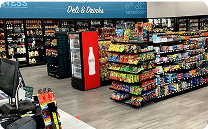In This article
Data integration refers to the structured process of bringing together information from multiple, often disparate sources, such as video surveillance systems, point-of-sale (POS) terminals, access control logs, alarms, and case management platforms, into a centralized system to analyze and act upon.
For business environments, especially those managing multiple locations, data integration is vital in creating a cohesive picture of what’s happening across all touchpoints. Instead of working with isolated data streams, integrated systems can provide context-rich insights that link video to transactions to events, and alerts to root causes.
At its core, data integration helps eliminate data silos, which are isolated pockets of data within an organization that are not easily accessible by other parts of the organization. By breaking down these data silos, data integration reduces manual processes and supports faster, more accurate decision-making.
Why Data Integration Matters in Security and Surveillance
Data integration allows for real-time collaboration between different components of a surveillance ecosystem. For example:
- When a cash drawer is opened outside a transaction, the system can instantly link the point of sale (POS) timestamp to camera footage and send an alert.
- An access control event, like a denied badge scan, can be matched with video to verify who is attempting unauthorized entry.
- An incident documented in a case management system can include relevant video clips, alarm history, and employee data, all automatically attached for review.
This level of correlation between systems saves time and helps prevent incidents by identifying patterns and anomalies before they escalate. For instance, it can detect unusual employee behavior that might indicate a potential security threat or identify areas with high customer traffic that might need additional surveillance.
Common Sources Integrated in Surveillance Environments
Effective data integration in business surveillance systems may include:
- Video Management Systems (VMS).
- POS or transaction logs.
- Access control systems and badge readers.
- Alarm systems and motion detectors.
- Audit and case management platforms.
- Customer behavior analytics and dwell-time tracking.
When these sources are combined, the business can view the full context of an event, track it across systems, and derive insights that wouldn’t be visible through one data stream alone.
Benefits of Data Integration
By implementing data integration strategies, businesses can:
- Ensure faster and more accurate incident investigations.
- Link operational activity with surveillance footage for context and accountability.
- Uncover trends across systems, such as frequent policy violations tied to specific shifts or high-risk hours.
- Streamline loss prevention efforts by automating the connection between data points.
- Reduce manual reporting and duplication, freeing time for more strategic tasks.
- Enable centralized monitoring across multiple locations, reducing inconsistencies.
For example, if a theft occurs at one location, integrated systems can instantly surface similar activity patterns across other sites, helping regional managers take coordinated action and reduce repeat losses.
Data Integration Challenges
Successful data integration requires careful planning, system compatibility, and a clear understanding of what insights are needed. Challenges can include:
- Incompatible data formats between systems.
- Latency or synchronization issues.
- User access and permissions management.
- Balancing security and privacy when aggregating sensitive data.
Choosing vendors and platforms for interoperability and secure integrations can help overcome these barriers
DTiQ Connects the Dots
DTiQ enables seamless data integration across video cameras, POS, access control, and management systems, giving a unified view of operations and risk environment. The DTiQ 360iQ platform helps ensure nothing gets missed by integrating video, POS transactions, and alerts so teams can make informed decisions, respond faster, and enforce loss prevention across each location. Visit our website to see the extensive list of DTiQ’s integration partners.





























